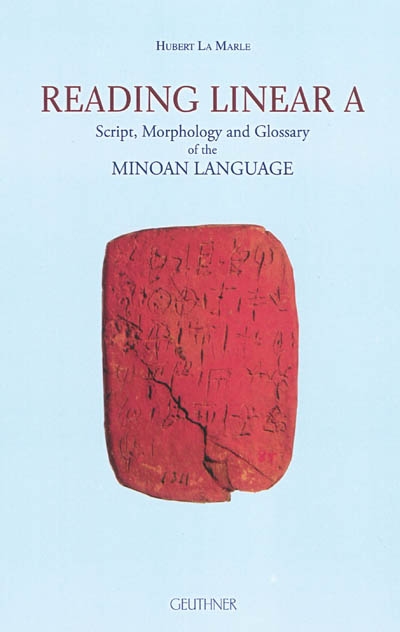en savoir plus

Permet à tous ses détenteurs d'obtenir 5% de réduction sur tous les livres lors du retrait en magasin (réduction non cumulable avec les réductions de type étudiant).
Offre également un certain nombre d'avantages auprès de nos partenaires.
Avec les favoris, retrouvez dans un espace les sélections effectuées au fur et à mesure de vos navigations dans le site.
Constituez pour votre usage personnel vos listes de livres en prévisions d'achats futurs et votre sélection d'articles, dossiers, événements, vidéos ou podcasts préférés ou à découvrir plus tard...
Il suffit simplement de cliquer sur "Ajout Favori" sur chaque page qui vous intéresse pour les retrouver ensuite dans votre espace personnel.
Requiert un compte Mollat
Requiert un compte Mollat
Reading linear A : script, morphology and glossary of the Minoan language
Auteur : Hubert La Marle
en savoir plus
Résumé
Une mise à jour des connaissances sur le linéaire A constituant vraisemblablement la première écriture non hiéroglyphique de l'Europe. L'ouvrage rassemble une méthodologie basée sur les fréquences, et décrit à la fois l'épigraphie de cette écriture complexe, forte de plus de 200 signes, sa lecture phonétique conventionnelle, sa morphologie et son lexique. ©Electre 2025
Quatrième de couverture
Linear A was one of the scripts used in Bronze Age Crete and the Cyclades from the Middle Minoan II to Late Minoan II periods, approximately 1800 to 1400 BC. Sir Arthur Evans, famed for his discovery of Knossos and the Minoan civilization, first identified the script more than a century ago. There are approximately 1,450 documents written in Linear A, five times as many as in the Minoan Hieroglyphic script, but far fewer than those in the Linear B script, which records the Mycenaean Greek language after 1400 BC. Previous attempts at decipherment based on presumed « homomorphisms » between Linear B and A do not make morphological sense. The corpus and frequency of the Linear A signs are completely different to those in Linear B and have nothing to do with Hittite, Luvian or Semitic.
This book is a summary and update of Hubert La Marle's analysis and reading of Linear A. His decipherment is presented in three parts : comparative palaeography, phonology, and morphology, accompanied by twelve tests of its validity. The morphology of the language transcribed by Linear A shows that it belongs to the Indo-Iranian language group, also dealt with here. In addition, there is a comparison between Linear A and the Eteocretan language of Crete's historical period with a Linear A glossary. The discovery that the Minoans wrote an Indo-Iranian language opens new avenues in linguistic research, and prompts renewed studies of ancient population movements between Asia and Europe.
Fiche Technique
Paru le : 06/05/2010
Thématique : Concours-Méthodologie Linguistique
Auteur(s) : Auteur : Hubert La Marle
Éditeur(s) :
Geuthner
Collection(s) : Non précisé.
Contributeur(s) : Préfacier : Joseph Alexander MacGillivray
Série(s) : Non précisé.
ISBN : 978-2-7053-3820-6
EAN13 : 9782705338206
Reliure : Broché
Pages : 155
Hauteur: 25.0 cm / Largeur 16.0 cm
Poids: 300 g

